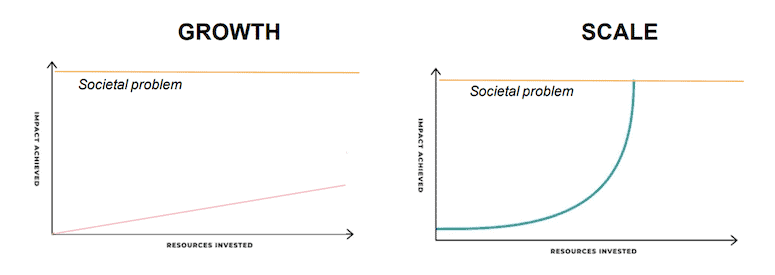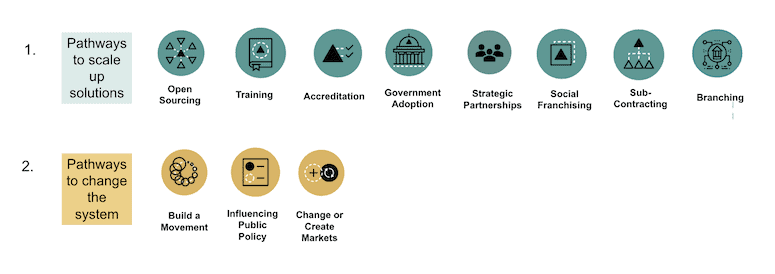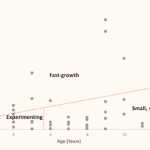Scaling Impact in the Last Mile Distribution Sector: The Pros and Cons of Different Pathways to Scale
Most solutions in global development are only scratching the surface of the huge challenges the world faces. It’s widely recognized that the only way to truly solve these growing problems is to develop solutions that can scale.
But what do we mean when we talk about scale? Simply put, scale is about increasing impact exponentially, relative to the size of the problem, while adding resources incrementally. This is distinct from growth, in which impact is increased at the same rate as resources are consumed.

Image credit: Spring Impact
Without this exponential growth, even promising solutions may struggle to address the world’s escalating challenges — and last mile distribution (LMD) is no exception. The sector has gained significant momentum, with members of the Global Distributors Collective (GDC) alone having reached more than 40 million underserved consumers collectively, according to our estimates. Yet there is still a huge discrepancy between the size of the problem (i.e., last mile consumers’ lack of access to beneficial products and services) and the solutions that currently exist. Last mile distributors (LMDs) who seek to achieve impact at scale must think about how to close this gap, assessing the impact they are having in relation to the problems they seek to solve.
This article describes a range of options for scaling LMD solutions, based on our work at the GDC and Spring Impact. Below, we’ll discuss some examples of GDC members who have successfully scaled using one of these approaches, and share resources Spring Impact has designed to help LMDs make informed scaling decisions.
Common pathways to scale in last mile distribution
There are different ways to scale impact to close the gap between problems and solutions. Spring Impact divides these scaling pathways into two main categories:
- Pathways to scale up solutions, to serve more people who are experiencing the problem
- Pathways to change the system in which the problem exists, and thereby reduce the size of the problem itself
Since LMDs are typically focussed on the immediate problem of how to bring beneficial products to underserved customers, they tend to pursue the first pathway: scaling up their own solutions locally, nationally and sometimes internationally. But some LMDs buck this trend by focusing on wider systems change beyond their day-to-day operations. The graphic below shows some examples of these different categories of pathways.

Image credit: Spring Impact
Which pathways do last mile distributors adopt to scale their solutions?
The most common pathway LMDs adopt to scale their solutions is branching — i.e., setting up wholly owned organisational units that are managed and controlled by the central organisation, with local staff operating the branch but reporting directly to the central office. Generally, organisations will default to this pathway without intentionally considering the advantages and disadvantages it offers compared to other pathways. Branching can be costly and time-consuming, and it does not always embrace or harness local resources and innovations. But on the other hand, it provides a high degree of control, and less risk to the organisation’s pre-existing brand.
Some successful examples of branching from the GDC membership include:
- Bidhaa Sasa, which sells lighting, cooking and agricultural products through a woman-to-woman direct sales distribution model. With support from the GDC, Bidhaa Sasa expanded this proven model from Kenya into Uganda, by employing a LEAN Startup Approach to adapt their business model to a new environment.
- Sistema.bio, which sells biodigesters to smallholder farmers, offering product demonstrations, site diagnostics, manufacturing, installation servicing and capacity-building support to customers. Sistema.bio has expanded its distribution from Mexico to Nicaragua, Colombia, Kenya and India.
- Nazava, which developed one of Southeast Asia’s best-selling water filters. They originally manufactured and distributed their products only in Indonesia, before expanding to offer their range of filters and spare parts to customers in Kenya.
In each case, these LMDs needed to stay laser-focused on understanding customer demand and meeting it through their unique value proposition, ensuring that they were achieving product and market fit by experimenting with prices, incentives and even suppliers.
The second most common scaling pathway adopted by LMDs is strategic partnerships, in which an organisation enters into an agreement to collaborate with one or more partners to jointly deliver a solution. This can be a quick path for both organisations to expand their reach and brand awareness, by taking advantage of partner strengths and mitigating any partner weaknesses in a complementary way. However, it can be challenging for organisations to put their reputation in the hands of an external partner. Relying on the partner to represent your organisation requires a great deal of trust that their approach to implementation will bolster your brand rather than tarnish it.
Strategic partnerships can take many different forms, but examples in the LMD sector include:
- Pollinate Group (formerly Pollinate Energy) sells lighting products and cooking appliances through a woman-to-woman direct sales distribution model in India. Pollinate merged with Nepal’s Empower Generation and continues to deliver positive social impact in both countries under the Pollinate Group brand.
- Essmart connects rural retail shops with last mile customers in India via an e-commerce platform. To bring more beneficial products to rural Indian markets, Essmart partnered with One Acre Fund, which provides smallholder farmers with naturally-produced hybrid seed, quality fertilizer and training on farming best practices. The partnership allows Essmart to reach more rural customers by leveraging One Acre Fund’s relationships with the farming community.
- Solar Sister trains women to deliver clean energy directly to homes in rural Nigeria and Tanzania, and provides them with other types of support. In 2022 it merged with LivelyHoods Kenya, which was offering beneficial products such as solar lamps and clean cookstoves through a youth-powered distribution network.
A third approach to scaling which we see in the LMD sector — albeit less frequently than the two approaches discussed above — is to develop and leverage relationships with the government, aligning the organisational proposition with local or national priorities and encouraging government adoption. This approach can lead to wide, long-term and sustainable impact, as the government is a critical player in ensuring that solutions reach communities at scale, and can add significant credibility to a LMD proposition. On the other hand, there can be substantial differences in culture and approach to execution between the distributor and local or national government departments, and these differences need to be carefully navigated to increase the chances of a successful partnership.
An example of this approach from the LMD sector is Livewell in Zambia, which provides training and other support to a network of Community Health Entrepreneurs who distribute health products in rural and peri-urban communities. Livewell’s local presence and understanding of its target communities enable it to work closely with government institutions at the national and local levels, building on the existing public healthcare infrastructure to transform access to healthcare.
Another pathway to scale: systems change in last mile distribution
For LMDs that identify a need to go beyond “just” scaling their own solutions, system change offers a compelling option. Affecting systems-level change is hugely challenging, and requires extensive stakeholder engagement, coalition-building and alignment of incentives towards shared goals. However, when such an approach is implemented well, it has the advantage of more widespread impact, like a rising tide that lifts all boats. As individual organisations which are often small and operating in isolation from one another, the capacity of LMDs to undertake these kinds of activities can be limited. This is the reason that the Global Distributors Collective was set up in the first place: to build the LMD sector as a whole by leveraging economies of scale, driving innovation and attracting more capital.
Spring Impact has seen that, as mission-driven organisations evolve over time, they tend to focus more heavily on systems-level pathways to scale. This is because they recognise that it’s unrealistic for them to solve the problem they’re tackling solely by scaling up their solution: They also need to work more holistically to reduce the size of the problem itself.
Some exciting examples of LMDs pursuing systems change include:
- SolarAid, a non-profit which gathers the data and information necessary to build government, donor and investor confidence in off-grid solar solutions, thereby seeking to influence both policy and capital flows. Along with bringing these solutions to previously excluded communities, SolarAid amplifies the voice of these underserved populations in relevant forums and conversations, while also supporting partnerships and cross-sector collaboration — for example, with private sector organisations that have the capacity to emulate SolarAid’s successes and learn from its failures.
- Frontier Markets, which developed the She Leads Bharat initiative, through which corporations, NGOs, governments, funders and investors work together to create long-term income opportunities for rural women and their communities in India.
- Pollinate Group, which offers a range of immersive fellowship programs designed to build a movement that empowers individuals to create lasting impact in the lives of marginalised communities. The programs attract students, young professionals and more mature changemakers who want to make a positive social impact, and offer them a platform through which they can contribute to sustainable development.
Conclusion and additional resources
Each pathway to scale has its advantages, disadvantages and success factors. Key considerations when deciding which pathway(s) a LMD should pursue include the nature of the problem the distributor is trying to solve, the complexity of its distribution model, the availability of partnership opportunities, and the role the LMD intends to play within the wider ecosystem.
To scale successfully, LMDs will likely need to adapt their business model several times as they learn about new markets, distribution networks and customer segments. The process of scaling will inevitably stretch their organisational capacity, meaning LMDs need to allocate sufficient time to understanding their own organisational strengths and weaknesses, generating alignment across key decision-makers (such as their shareholders, board of directors and C-suite team) and ensuring that the right resources (people, systems and funds) are available to support the scaling journey. In terms of the necessary resources for scale, securing appropriate funding is particularly important for LMDs, as they have less room to make expensive mistakes than their better-capitalised counterparts in the private sector.
To find out more about scaling pathways, see the Spring Impact tool “Choosing a Scale Pathway.” You can also watch the GDC webinar, “Models for scaling your last mile distribution company,” which illustrates some of the success factors and common challenges related to developing a sustainable scaling strategy.
Russell Lyseight is Head of the Global Distributors Collective, and Emma Colenbrander is Managing Director at Spring Impact. This article was authored with support from British International Investment (BII).
Photo credit: Molly Bergen/WCS, WWF, WRI
- Categories
- Agriculture, Energy



